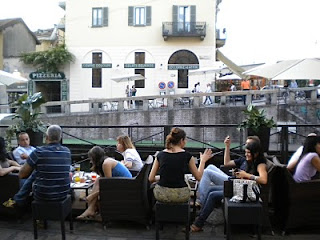The flight from Milan to Rome is an easy one. We dropped into Fuimico airport and I was happy for the airconditioning for another hot day in Rome. I had tried to make a hotel reservation and the Internet listed a couple of them. The most reasonably priced was the Trani Rooms, Address: VIA BUONARROTI 39, Rome - Fiumicino, 00185, Italy I reserved a room and double checked the room location via Google maps. Surprise! The hotel is smack dab in the center of Rome. I canceled.

I thought about the possibility of at least getting a good meal at a nearby Hilton. Staying there was never a plan- $200 to $300 per night for a single. I asked about the possibility of walking to the Hilton and found that the path parelleled the path to the train station. I walked into the hotel with my three bags - suitcase, guitar, and "man purse". They politely checked in my bags and gave me a receipt so I could eat unemcumbered.
The buffet was the recommended fare for an all you can eat Italian meal- 38 Euro. I got my money's worth. I also ordered a glass of wine, which turned out to be one of the best Marche wines that I had ever tasted. My waiter was from Marche and I told him of the wonderful family that we knew in San Benedetto.
I could hear a crowd gathering in the nearby lounge. The semifinal Mondiale between Germany and Spain was about to begin. I saw a free seat next to a couple watching the game preliminaries on the large TV screen. "Posso?" (May I?). I said. "Si, certo!" the man responded. He was a handsome bald middle age man, who looked quite a bit like Andre Agassi. She was thin, young, stylish and beautiful. He motioned toward the sportcaster on the screen and said that he knew the man and that he had designed those glasses he was wearing. He made a gesture to sign that the glasses that I was wearing were "mezzo"- half, middle of the road. He apologized, but said that was his business- designing eyeglasses. His girlfriend had just flown in frm Belarus. He guessed that I was some kind of international real estate wheeler dealer. I confessed that I was only "un instructor" or "un professor".
I was particularly partial to Spain. Two German gentlemen sat in front of me. When Spain scored their goal, the Italians in the room cheered. The two Germans turned around with a look of part surprise and part fear. Oblivious of history I supposed they were thinking "What did we ever do to them?"
Once the game was over, I collected my gear and walked back to the airport. A young Frenchman joined me on the way back saying that he thought that 200 Euros at the Hilton was a little steep. I agreed. I said that many people spent the night in the airport, and that I would help him find a place. We found a nice quiet and flat spot for him to crash. I proceeded to walk around for a little while, then found a free rack of seats in a quiet corner.
I rose at about 4 AM for my 6 AM flight to Lisbon. Lisbon airport was as I remembered it, clean and bustling. I purchased a nice bottle of port and waited for the plane. Security was especially tight. Many people had to open their bags. There was serious questioning and body searches. Three young men carried only a few plastic bags as luggage. The guards found rocks. I assumed from some hiking trip. All the bags were confiscated. The flight to Newark was very pleasant; after that, another story.































